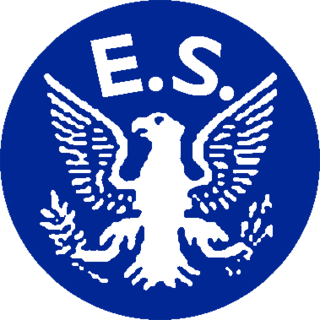
The Eagle Squadrons were three fighter squadrons of the Royal Air Force (RAF) formed with volunteer pilots from the United States during the early days of World War II, prior to America's entry into the war in December 1941.
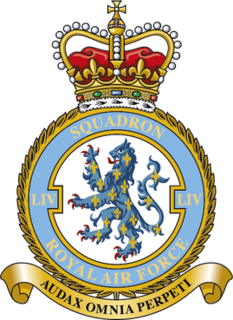
Number 54 Squadron is a squadron of the Royal Air Force. It is based at RAF Waddington, England. On 1 September 2005 it took on the role of Intelligence, Surveillance and Reconnaissance (ISR) Operational Conversion Unit, responsible for training all RAF crews assigned to the E-3D Sentry AEW1 and the Nimrod R1 and the Sentinel R1 as well as running the Qualified Weapons Instructor Intelligence, Surveillance and Reconnaissance Course. The squadron was previously a SEPECAT Jaguar strike fighter unit, operating from RAF Coltishall, until it was disbanded on 11 March 2005. Since September 2005 the unit has been formally titled 54(Reserve) Squadron, until the (Reserve) nameplate was removed from all training squadrons in 2018.
No. 610 Squadron of the Royal Air Force was a Squadron of the Auxiliary Air Force. Comprising very high quality pilots, often ex-RAF officers and occasionally locally based company Test pilots from companies such as de Havilland and Airwork. Its pilots were initially part timers who would spend their weekends and spare time flying and practising combat manoeuvres. The squadron was named the "County of Chester" and adopted the motto "Alifero tollitur axe ceres"; which translates as "Ceres rising in a winged chariot". Ceres being the Roman Goddess of Wheat, a reference to Chester's Agricultural sector. Its badge contained the image of a garb.
No. 118 Squadron was a squadron of the British Royal Air Force. Originally formed in 1918, it served as a fighter squadron in the Second World War, flying Spitfires and Mustangs. It flew jet fighters as part of RAF Germany in the 1950s, and Bristol Sycamore helicopters in Northern Ireland before finally disbanding in 1962.
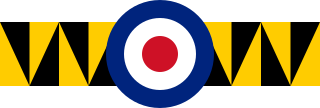
Number 74 Squadron, also known as "Tiger Squadron" from its tiger-head motif, was a squadron of the Royal Air Force. It operated fighter aircraft from 1917 to the 1990s, and then trainers until its disbandment in 2000. It was the Royal Air Force's member of the NATO Tiger Association from 1961 until the squadron's disbandment, it has since been replaced by No. 230 Squadron.

Number 332 Squadron of the Royal Air Force was formed at RAF Catterick in the North Riding of Yorkshire on 16 January 1942, as a Supermarine Spitfire-equipped fighter squadron manned by Norwegians.

No. 331 Squadron RAF was a Second World War squadron of the Royal Air Force. The squadron was primarily manned with Norwegian aircrew. The squadron was part of Fighter Command between 1941 and March 1944 when it joined the 2nd Tactical Air Force until the end of the war. The squadron took part in the Dieppe Raid and the Normandy landings.

No. 313 Squadron RAF was a Czechoslovak-manned fighter squadron of the Royal Air Force in the Second World War.

No. 452 Squadron is a Royal Australian Air Force (RAAF) air traffic control unit. It was established in 1941 as a fighter squadron, in accordance with Article XV of the Empire Air Training Scheme during World War II. The squadron flew Supermarine Spitfires for the entire war, initially over the United Kingdom and Nazi-occupied Europe. It was later based in Australia and the Netherlands East Indies, before being disbanded in 1945. It was re-raised in its current role in February 2011.

Number 92 Squadron, also known as No. 92 Squadron and currently as No. 92 Tactics and Training Squadron, of the Royal Air Force is a test and evaluation squadron based at RAF Waddington, Lincolnshire. It was formed as part of the Royal Flying Corps at London Colney as a fighter squadron on 1 September 1917. It deployed to France in July 1918 and saw action for just four months, until the end of the war. During the conflict it flew both air superiority and direct ground support missions. It was disbanded at Eil on 7 August 1919. Reformed on 10 October 1939, the unit was supposed to be equipped with medium bombers but in the spring of 1940 it became one of the first RAF units to receive the Supermarine Spitfire, going on to fight in the Battle of Britain.

No. 306 Polish Fighter Squadron was a Polish fighter squadron formed in Great Britain as part of an agreement between the Polish Government in Exile and the United Kingdom in 1940. It was one of several Polish fighter squadrons fighting alongside the Royal Air Force during World War II.

No. 307 Polish Night Fighter Squadron was a Polish night fighter squadron formed in Great Britain on 24 August 1940 following an agreement between the Polish Government in Exile and the United Kingdom. It was the only Polish night fighter squadron fighting alongside the Royal Air Force during World War II. 307 Squadron is named after the Polish city of Lwów, and nicknamed "Eagle Owls".

No 501 Squadron was the fourteenth of the twenty-one flying units in the Royal Auxiliary Air Force, the volunteer reserve part of the British Royal Air Force. The squadron won seven battle honours, flying Hurricane, Spitfire and Tempest fighter aircraft during World War II, and was one of the most heavily engaged units in RAF Fighter Command. In particular, the Squadron saw extensive action during the Battle of France and Battle of Britain. At present the unit is not flying any more and has a logistics role as part of No 85 Expeditionary Logistics Wing.

The name No. 67 Squadron has been used by the Royal Flying Corps and the Royal Air Force for two quite different units.

Royal Air Force Station Chilbolton or RAF Chilbolton is a former Royal Air Force station in Hampshire, England. The airfield is located in Chilbolton approximately 4 miles (6.4 km) south-southeast of Andover; about 62 miles (100 km) southwest of London

349th Squadron is a fighter squadron in the Air Component of the Belgian Armed Forces. The squadron traces its origins to No. 349 (Belgian) Squadron of the Royal Air Force, founded in 1942 as part of the Free Belgian forces during World War II. It was transferred to the re-established Belgian Air Force in 1946, together with 350th Squadron. Considered a "honorary" squadron, it retained its original name and numbering and has been flying under the Belgian flag ever since. Today it is part of the 10th Tactical Wing, operating the F-16 Fighting Falcon from Kleine Brogel airbase.

The 350th Squadron is a fighter squadron in the Air Component of the Belgian Armed Forces. It was originally formed in 1941 as No. 350 (Belgian) Squadron of the Royal Air Force during World War II. The unit was transferred to the Belgian Air Force, together with 349th Squadron, in 1946. The unit is now part of the 2nd Tactical Wing and operates F-16 Fighting Falcons.
No. 225 Squadron RAF is a former Royal Air Force squadron.
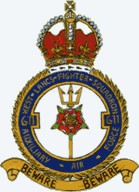
No. 611 Squadron is a British Royal Air Force squadron. It was first formed in 1936 and was disbanded in 1957 after seeing combat as a fighter unit during the Second World War. It was reformed as a reserve squadron in 2013.
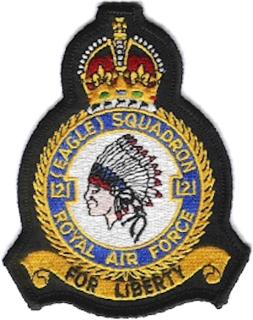
No. 121 Squadron was a Royal Air Force (RAF) aircraft squadron that during the Second World War was one of the three Eagle Squadrons manned by American volunteers. The squadron today is part of the Royal Air Force Air Cadets in Nuneaton.


















